by W.R. Jacobi* (12/13)
Quick Facts…
- Cankers and root collar rot are the major diseases of honeylocusts because they can girdle the stem and kill the tree.
- Canker disease symptoms include sunken, dead areas of bark; dieback; reduced foliage; yellow foliage; premature fall coloration; and early leaf drop.
- To control canker diseases, prevent wounds and stress and promote of tree vigor.
- Root collar rot symptoms include premature fall coloration and discolored bark and wood at the ground line.
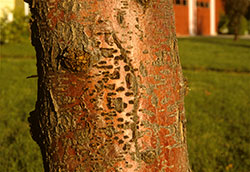
Figure 1: Asexual fruiting mats pushing through bark lenticels of Thyronectria canker. |
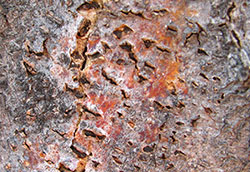
Figure 2: Asexual fruiting bodies in bark cracks of Thyronectria canker. |
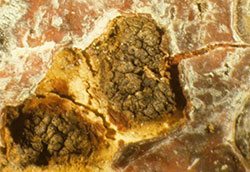
Figure 3: Thyronectria asexual fruiting bodies. |
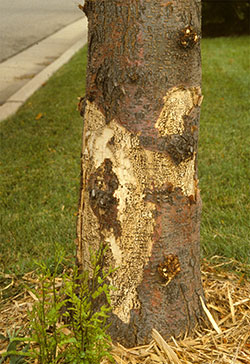
Figure 4: Black spot Nectria canker with asexual fruiting bodies. |

Figure 5: Black spot Nectria canker at branch junction. |
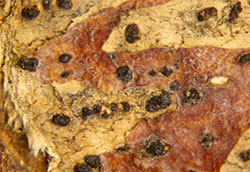
Figure 6: Asexual sporodochia of Black spot Nectria canker. |
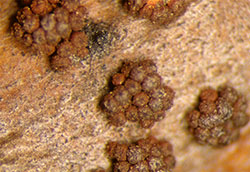
Figure 7: Sexual fruiting bodies (peritheica) of Black spot Nectria canker. |
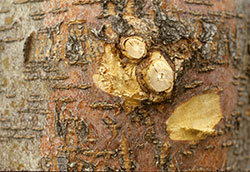
Figure 8: Coral spot Nectria on honeylocust with bark discoloration. |
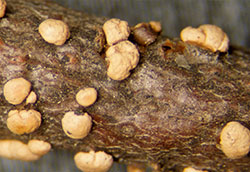
Figure 9: Asexual fruiting bodies (sporodochia) of Coral spot Nectria canker. |
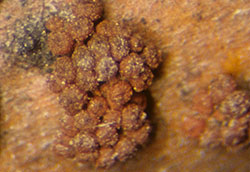
Figure 10: Sexual perithecia of Coral spot nectria. |
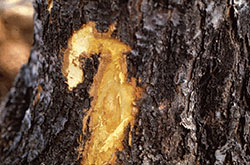
Figure 11: Collar rot symptoms – white, exposed bark and wood are healthy, while yellowish, exposed bark indicates early symptoms of collar rot. |
Thyronectria and Black spot Nectria cankers are common on honeylocusts and occasionally Coral spot Nectria cankers are noted.
Thyronectria canker is caused by the fungus Pleonectria austroamericana (Thyronectria austroamericana).
Black spot Nectria canker is caused by Nectria nigrescens (Tubercularia ulmea).
Coral spot Nectria canker is caused by Nectria cinnabarina.
Root collar rot, a disease caused by soil microorganisms, kills the bark and outer wood on honeylocusts at the ground line, essentially girdling the tree by a canker. All ages and cultivars of honeylocust, including thornless and podless cultivars, are susceptible to cankers and collar rot.
Symptoms and Signs
Cankers
Disease symptoms include dieback of affected branches, reduced foliage, yellow foliage, premature fall coloration and early leaf drop. Cankers (areas of dead tissue) are found at the base of trees, at branch crotches, around wounds or on branch stubs. Cankers can range from slightly flattened surfaces to distinctly sunken areas with large callus ridges at the canker margin. Areas of stems and branches with thin bark may have a red-yellow discoloration. The condition of the bark and cambium (the tree’s growth tissue, between bark and wood) can indicate the presence of a canker. Infected bark and cambium will be loose and wood beneath them may have a dark, wine-red to yellow discoloration instead of a normal white or light color. The reddish color associated with the center of honeylocust stems is not related to these diseases.
Diagnosis of the disease is easier if fruiting bodies (the spore-producing structures) of the fungi are present. Look for fruiting bodies in areas of the bark that have been dead for a year or less. Samples should be sent to a plant health clinic for culturing or microscopic confirmation.
Thyronectria cankers caused by Pleonectria austroamericana have bumpy, cushion-like asexual fruiting bodies that are light yellow-brown when fresh but blacken with age. It also produces sexual fruiting bodies (perithecia) that are reddish-brown and also darken. Fruiting bodies usually are found in bark openings, such as lenticels (raised areas of bark that act as breathing pores) and scattered on bark surfaces in thinbarked areas. Large lenticels should not be confused with fruiting bodies.
Black spot Nectria cankers, caused by Nectria nigrescens, appear very similar to Thyronectria cankers, and are best distinguished from P. austroamericana by cultural characteristics, morphology of the asexual fruiting structures, and ascospore morphology. The asexual fruiting bodies are raised bumps on the bark (sporodochia) and are creamy to peach colored when fresh, but normally turn dark brown to black within a few days of drying conditions. They usually form under a thin layer of bark or are exposed on the bark surface. The sexual fruiting bodies (perithecia) are round flask shaped and reddish brown, solitary or up to 20 on a raised mass of fungal tissue (stroma) and can be found clustered at base of sporodochia.
Coral spot Nectria cankers caused by Nectria cinnabarina appear similar to the two other cankers but N. cinnabarina cankers may contain raised smooth fungal masses (sporodochia) that are creamy to coral colored when young (usually for several weeks) and tan, brown or black when mature. The sexual fruiting bodies that look like small round flasks (perithecia) form in late summer singly or in groups up to 15 and are bright red to reddish-brown.
Root Collar Rot
Symptoms of root collar rot need to be recognized promptly because the disease can rapidly kill trees. Early fall coloration of a portion of the tree may indicate a large amount of damage. Small drops of gum on the stem near the ground or farther up the stem usually indicate that collar rot girdling occurred below that point. Loose bark and discolored wood (yellow to brown instead of white) just below the bark indicate initial collar rot and are the most indicative symptoms. Extensive death and discoloration of bark and wood can occur over several months. Black spot Nectria or Thyronectria cankers at the tree’s base usually indicate collar rot is active or was active in the past.
Disease Cycle
Cankers
These fungi overwinter on infected trees as vegetative material (mycelium) and fruiting structures. Since the fungi also can live in dead tissue, they can become established or produce spores on dead wood such as branch stubs, wound edges or firewood. High humidity and wind-driven rain favor spore release and infection. Infections may take place through branch crotches, pruning wounds or other wounds in the bark.
The fungus grows in the bark, cambium, and outer wood, where it eventually kills the cambium and surrounding cells. Death of the tree or affected parts occurs because of cambial death. Fruiting bodies can form within one month after the tree bark is killed and are abundant on dying or dead trees.
Root Collar Rot
Frequent watering in heavy clay soils may induce soil microorganisms to kill the bark and cambium at the tree base just below ground-line. Thyronectria or Black spot Nectria fungi may then infect the weakened tree above the area previously killed by collar rot.
Damage and Control
Cankers at the tree base usually are fatal. Main stem or branch crotch cankers may completely girdle the tree, depending on the tree’s health. Stressed trees cannot stop the fungus, whereas healthy trees may be able to stop canker expansion and recover.
Root collar rot is common in urban areas in Colorado and nearby states and is responsible for the death of many of the honeylocusts killed by disease.
Cankers
The best way to control cankers is to prevent wounds and promote tree vigor. Any injury to the base of a honeylocust is potentially an entry point for fungi. Lawnmowers, weed trimmers and construction work commonly cause basal injuries. Injuries to the stem and trunk, such as those caused by squirrel gnawing, pruning and sunscald, can be minimized by proper action. Should physical damage occur, remove loose bark and allow the wound to dry.
A variety of stresses predispose honeylocusts to infection by canker fungi. To help prevent infection, avoid stress due to improper planting practices, drought, overwatering and insufficient area and oxygen for root growth.
In general, planting small trees such as 2 to 9 cm diameter trees (1 to 3 inches) will ensure successful establishment rather than planting large trees >10 cm (>4 inches). Water trees adequately with about 2.5 cm (1 inch) of water per week. Avoid over watering trees since their roots need oxygen.
Prune dead or infected branches to reduce the chance of other infections. Prune cankers on limbs by cutting at a branch junction and at least 30 cm (1 ft) below the visible margin of the canker. Prune in cool, dry weather to minimize reinfection. Cut out small cankers on main stems. Remove dead or dying bark and discolored wood. The area of bark removed should extend 2.5 cm (1 inch) into healthy tissue. If the tree appears to be recovering, however, do not cut into healthy tissue. Wound dressings are not recommended. Disinfect all tools used to prune and cut. Spray with Lysol® or dip in 70 percent rubbing alcohol or a 10 percent bleach solution (one part bleach to nine parts water) and dry after each cut.
Prompt removal of all infected trees reduces the chance of spreading the infection. Because canker fungi can grow on dead wood and produce spores that can infect nearby trees, keep the wood dry, bury it in a landfill or burn it within three weeks of cutting.
Research shows Sunburst honeylocust is the most susceptible to cankers, while Imperial, Skyline, Trueshade, and Thornless are most resistant.
Root Collar Rot
Allow the soil at the tree base to dry out between irrigation events to prevent bark death at the soil line. Frequent irrigation of turf is the primary factor related to this disease. Place sprinklers and sprinkler heads far away from trees to keep the least amount of water from falling on the tree stem and at the tree base. Remove flowers, turf or other vegetation from around the tree’s base to help keep the soil dry. Replace soil with small gravel or mulch at the tree base to help prevent water. Plastic on the soil around the tree base may or may not promote the disease, depending on the amount of moisture retained in the soil.
1 Colorado State University professor, bioagricultural sciences and pest management. 6/94. Revised 12/13.
Go to top of this page.





